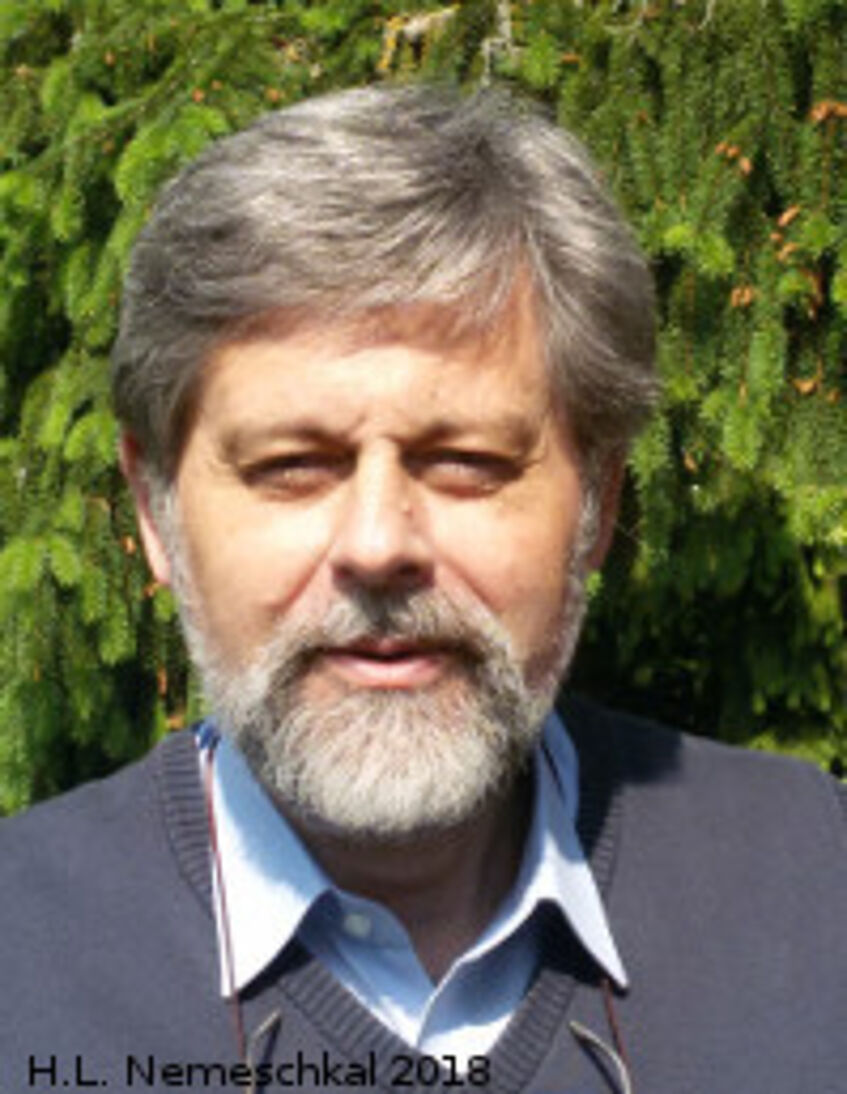About me
Topics of current scientific interest: phenotypic integration, natural and sexual selection, assortative mating
For the near future: history of science (with an Austrian focus)
Publication list
2019
Bright, M., Espada-Hinojosa, S., Volland, J.-M., Drexel, J., Kesting, J., Kolar, I., Morchner, D., Nussbaumer, A., Ott, J., Scharhauser, F., Schuster, L., Zambalos, H. C., & Nemeschkal, H. L. (2019). Thiotrophic bacterial symbiont induces polyphenism in giant ciliate host Zoothamnium niveum. Scientific Reports, 9, Article 15081. https://doi.org/10.1038/s41598-019-51511-3
Laciny, A., Nemeschkal, H. L., Zettel, H., Metscher, B., & Druzhinina, I. S. (2019). Caste-specific morphological modularity in the ant tribe Camponotini (Hymenoptera, Formicidae). BMC Zoology, 4(1), Article 9. https://doi.org/10.1186/s40850-019-0048-7
2018
Lange, A., Nemeschkal, H. L., & Müller, G. (2018). A threshold model for polydactyly. Progress in Biophysics and Molecular Biology, 137, 1-11. https://doi.org/10.1016/j.pbiomolbio.2018.04.007
2016
Ramler, D., Ahnelt, H., Nemeschkal, H. L., & Keckeis, H. (2016). The drift of early life stages of Percidae and Gobiidae (Pisces: Teleostei) in a free-flowing section of the Austrian Danube. Hydrobiologia: the international journal on limnology and marine sciences, 781(1), 199-216. https://doi.org/10.1007/s10750-016-2845-0
2015
Laciny, A., & Nemeschkal, H. L. (2015). Disassortative parasitic infestation by larval mites of the genus Trombidium (Acari: Trombidiidae) influences mate choice in a population of the cantharid beetle Rhagonycha fulva Scopoli, 1763 (Insecta: Coleoptera: Cantharidae). Entomologica Austriaca: Zeitschrift der Österreichischen Entomologischen Gesellschaft, 22, 75-89.
Müller, G. B., & Nemeschkal, H. L. (2015). Zoologie im Hauch der Moderne: Vom Typus zum offenen System. In K. A. Fröschl (Ed.), Reflexive Innensichten aus der Universität Wien: Wiener Disziplingeschichten zwischen Wissenschaft, Gesellschaft und Politik (pp. 355-369). V&R unipress, Vienna University Press.
Wilhelm, G., Handschuh, S., Plant, J., & Nemeschkal, H. L. (2015). Selection becomes visible: Manifestation of enforced sexual dimorphism caused by sexual selection in the weevil Rhopalapion longirostre (Olivier 1807) (Coleoptera: Curculionoidea: Brentidae). Biological Journal of the Linnean Society: a journal of evolution.
2014
Lange, A., Nemeschkal, H. L., & Müller, G. B. (2014). Biased Polyphenism in Polydactylous Cats Carrying a Single Point Mutation: The Hemingway Model for Digit Novelty. Evolutionary Biology, 41(2), 262-275. https://doi.org/10.1007/s11692-013-9267-y
2012
Schindler, S., Hohmann, U., Probst, R., Nemeschkal, H. L., & Spitzer, G. (2012). TERRITORIALITY AND HABITAT USE OF COMMON BUZZARDS (BUTEO BUTEO) DURING LATE AUTUMN IN NORTHERN GERMANY. The Journal of Raptor Research, 46(2), 149-157. https://doi.org/10.3356/JRR-11-22.1
2011
Handschuh, S., Plant, J., & Nemeschkal, H. L. (2011). Sexual dimorphism in head structures of the weevil Rhopalapion longirostre (Olivier 1807) (Coleoptera: Curculionoidea): a response to ecological demands of egg deposition. Biological Journal of the Linnean Society: a journal of evolution, 104(3), 642-660. https://doi.org/10.1111/j.1095-8312.2011.01751.x
Probst, R., Nemeschkal, H. L., McGrady, M. J., Tucakov, M., & Szep, T. (2011). Aerial hunting techniques and predation success of Hobbies Falco subbuteo on Sand Martin Riparia riparia at breeding colonies. Ardea: Nederlandse Ornithologische Unie, 99(1), 9-16. https://doi.org/10.5253/078.099.0102
2010
Wilhelm, G., Nemeschkal, H. L., Plant, J., & Paulus, H. (2010). Fitness components in the relationship between Rhopalapion longirostre (Olivier, 1807) (Insecta: Coleoptera: Apionidae) and Alcea rosea (Linnaeus, 1758) (Malvaceae). Analysis of infestation balance of a herbivorous weevil and its host plant. Bonn zoological Bulletin, 57(1), 55-64. http://www.zfmk.de/BZB/Band_57/BzB_57_1_Wilhelm.pdf
2009
Elzen, R. V. D., & Nemeschkal, H. L. (2009). The impact of body mass on morphological integration in avian skeletons (Aves, Fringillidae and Carduelidae). Bonner Zoologische Beiträge, 56, 25-35.
Nemeschkal, H. L., Krenn, H., & Eberhard, S. (2009). Biometrical evidence for adaptations of the salivary glands to pollen feeding in Heliconius butterflies (Lepidoptera: Nymphalidae). Biological Journal of the Linnean Society: a journal of evolution, 97, 604-612.
Schludermann, E., Keckeis, H., & Nemeschkal, H. L. (2009). Effect of initial size on daily growth and survival in freshwater /Chondrostoma nasusus/ larvae: a field survey. Journal of Fish Biology, 74(4), 939-955.
2007
Gollner, S., Zekely, J., Govenar, B., Le Bris, N., Nemeschkal, H. L., Fisher, C. R., & Bright, M. (2007). Tubeworm-associated permanent meiobenthic communities from two chemically different hydrothermal vent sites on the East Pacific Rise. Marine Ecology Progress Series, 337(1623), 39-49.
2006
Arnaiz-Villena, A., Nemeschkal, H. L., & Elzen, R. V. D. (2006). Molecular modules and morphology. Acta Zoologica: international journal for zoology, 505-508. http://www.actazool.org/paperdetail.asp?id=5126&volume=52&number=-101&bgpage=null&endpage=null&year=2006&month=null
Gollner, S., Zekely, J., Dover, C. L. V., Govenar, B., Le Bris, N., Nemeschkal, H. L., & Bright, M. (2006). Benthic copepod communities associated with tubeworm and mussel aggregations on the East Pacific Rise. Cahiers de Biologie Marine, 47, 397-402.
Nemeschkal, H. L., & Elzen, R. V. D. (2006). Variabilität im Skelettbau der Cardueliden - ökologisch, phylogenetisch, adaptiv oder konstruktionsmorphologisch dominiert? Ökologie der Vögel : Verhalten, Konstitution, Umwelt, 25, 231-247.
Zekely, J., Dover, C. L. V., Nemeschkal, H. L., & Bright, M. (2006). Hydrothermal vent meiobenthos associated with mytilid mussel aggregations from Mid-Atlantic Ridge and East Pacific Rise. Deep-Sea Research. Part 1: Oceanographic Research Papers, 53, 1363-1378.

